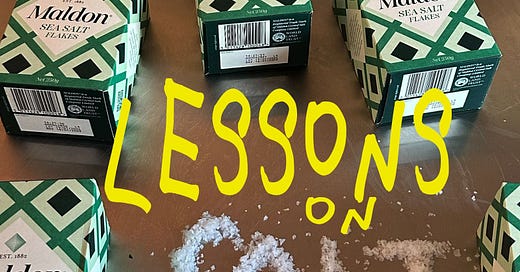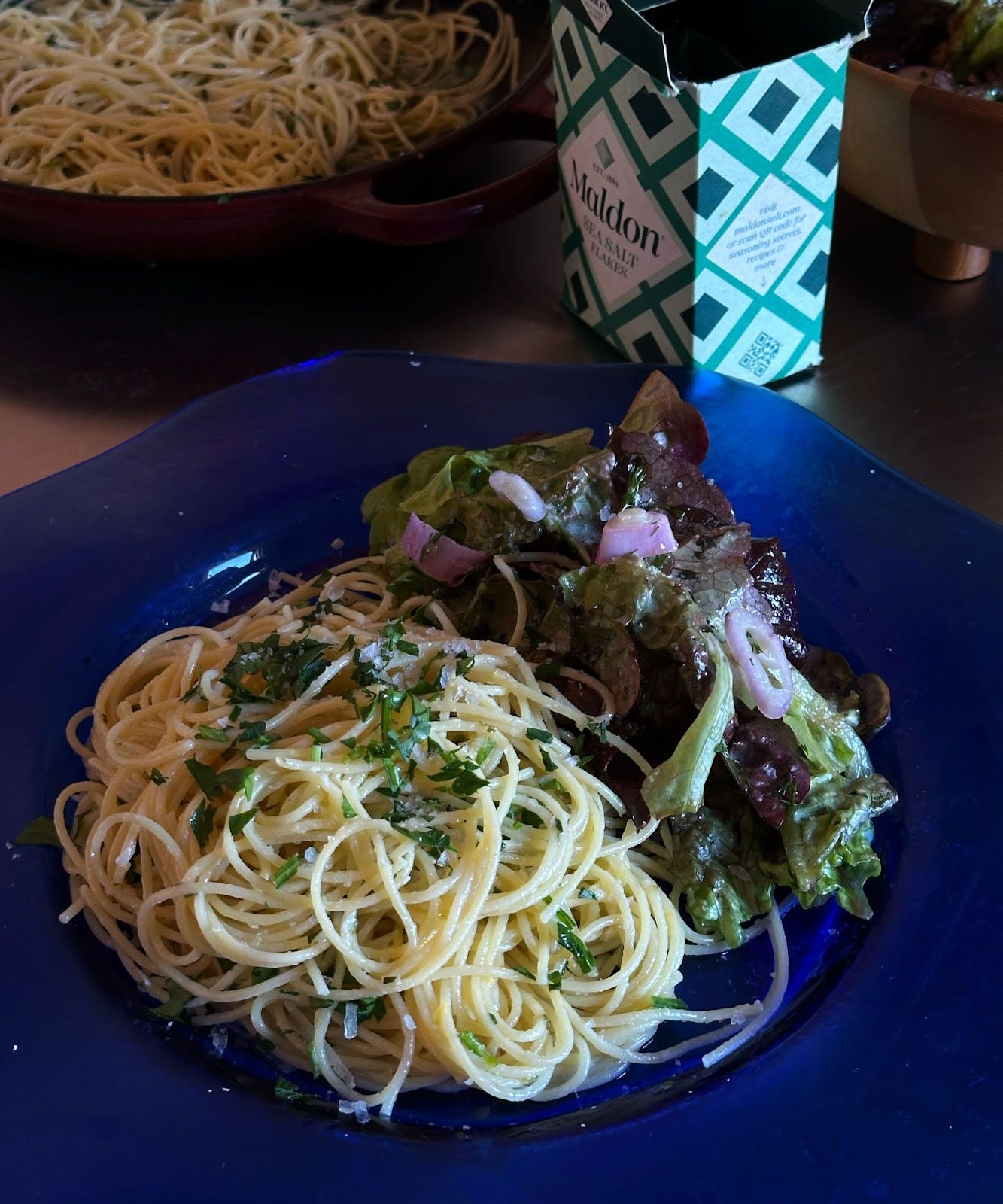Salt was never a common fixture on our dining table growing up. Somehow my mother was able to make hugely delicious meals with a teeny bit of salt in a ramekin that sat beside the stovetop, but otherwise it was hidden in the corner of the cupboard. Back then it was assumed that too much salt was not great for your health. So alongside my Mum's epic morning juicing schedule for the family, was the removal of the salt bottle.
This tiny act of hidden salt grew a tiny fear in me that salt could be a health enemy. Which is ironic, as I now have become a staunch warrior in the importance of salt in my cooking. When I moved into my first share house at 19 years old and began the task of being the lead chef in my own life, I remember my roommate having multiple types of salt on her shelf. I recall thinking: “THERE'S MORE THAN JUST TABLE SALT OUT THERE?”
As I made my slow way from cooking in my home for friends to cooking for the public and working with other chefs, I have been able to grab and grip onto some key lessons in working with salt to enhance the magic of the ingredients we cook with. The difference between a stock salted at the start and one salted at the end is extreme.
My first introduction to the world famous white crystals, Maldon Salt, was through chef and owner Ruth Rogers from The River Cafe in London. Her first cookbook released in 1995 literally states “you must use Maldon salt.” That was all I needed to hear from Ruthy to nab my first box and from then on, Maldon and I have been going steady.
If you snoop hard enough in the many kitchens across the world, you’ll notice almost immediately that Maldon is a top tier choice for many chefs and foodies alike. Jamie Oliver, Ina Garten and even THE QUEEN have given it the ultimate nod. With famed chef from ‘Salt, Acid, Fat and Heat’ Samin Nosrat referencing the iconic brand multiple times throughout her book. Demonstrating quite clearly that this famed variety of salt has the ability to add multiple layers of magic taste to our food whilst we cook.
Momentary history lesson for you all! Maldon began their iconic salt making in 1882 out of seaside town Maldon in Essex, England. The four generations of the Osborne family have meticulously crafted their unique art of salt extraction from the sea through a process of evaporation. The method they have used for over a century utilises the concept of temperature and timing. Brine evaporates in their salt pans over flames and slowly the crystal pyramids Maldon are known for, float to the surface which are extracted and dried out. The texture is flakey and the flavour is clean, as if you just consumed the freshest of ocean water onto your palette - which is the extreme dream of cooking and consuming with salt.
Similar to my early fear of salt, I have watched many people err on the side of caution for fear of over-salting, which is fair enough as nothing can ruin a perfect dish more than too much salt. However on the other side of that, not enough salt can really pull back the magic potential of your food. So, how do we find a lovely balance? Below I have gathered my best salty tips to help you in the kitchen as I have seen myself, the great impact that understanding this ingredient can have on brilliant cooking. Not even complicated cooking, just the everyday eats like eggs, salads and of course….pasta.
May you use Maldon with confidence and excitement, using these tips to extract the most amount of goodness from the dishes on your table. Use the below recipes I have shared to help you master your salt education with ease.
1. Salt Enhances Flavour
Whilst salt certainly has its own ‘flavour’, it also is an essential piece to bringing out the best flavour of the ingredients you are using. Our tongue hits five different tastes: salt, sour, sweet, bitter and umami and depending on their respective amounts, using these flavours cohesively is where extreme yumness comes from.
Salt concentration and application has the ability to suppress or enhance the other four tastes, however it best suppresses the bitter taste of things. Hence why salt and lemon go together so wonderfully, the salt decreases the bitter taste perception of the lemon. By adding salt to our ingredients, it helps particular molecules to be released and the concentration of flavour from the inside to be activated deeper. Salt legitimately locks in flavour and makes things taste better.
This is why having a piece of tomato on toast without salt is a 2 out of 10 on the flavour metre. However add a few sprinklings of Maldon flakes and it will automatically be kicked up to a 9 out of 10 (depending on your bread and tomatoes).
2. When To Salt - Layering Is Key
The timing of salting your food is a contentious topic, and I would be lying if I didn’t admit that for years pre-Pasta Mama I was the gal who just added salt at the end. Which I understand is a no no in most (but not all) cooking circumstances. The reason for this is that salt needs time to do its work by migrating into the ingredients and dissolving into the flavours of your food. When you add salt right at the end before serving and not throughout the cooking process, it will give a stronger, more concentrated salty taste that can overpower the flavours of the dish.
By adding your salt throughout the cooking process, you are layering it in a way that enhances each step of the recipe. I tend to check the saltiness of my food during most stages of a recipe. For instance, for a classic Ragu you would salt during these different steps:
Salting the meat before browning off
Salt during the soffritto (celery, carrot and onion cook off)
Salt when the tomatoes, wine and meat is reintroduced to the pot
Salt in the cooking pasta water
Finish salt on top before serving
Whilst that may seem like a lot of salt, missing those additions during the stages actually does have a huge impact on the final flavour, especially if you decided to just add salt at the end of the Ragu - it would be two different dishes.
However, this particular learning can be the opposite when cooking particular water filled vegetables. For example if you were to saute mushrooms and add salt at the start, the moisture would be pulled out from the shrooms leaving an abundance of unwanted wetness in your pan. In this instance you would salt just before you finish cooking them.
Always salt your meat a few hours or even the day before cooking, as the longer you have it seasoned the deeper the flavour will go. When boiling vegetables in water, salt added to the pot is crucial in preventing nutrients and flavour from leaching out. Similarly to a pot of boiling water for pasta, adding a good hunk of salt will penetrate the pasta dough and allow for a stronger bite of spaghetti.
3. How To Salt - Trust Your Tongue
Now that we know when to salt, let us learn the art of how to salt. The most important concept to remember is that you should “salt early and often” and slowly add little by little, layer by layer. The most important body part in your entire body when it comes to cooking is: your tongue. SO USE IT! It still blows my mind when I see people cooking without tasting as it’s your instant radar as to what needs to be added or balanced out.
Before every sprinkle of salt is added to the stages of my cooking, I use the historical art of tasting to decide. Over time as you learn to notice the subtle flavour enhancing skills that salt produces, you will be able to confidently identify with ease - how much salt needs to be added at what stages. Do not use a salt shaker bottle to measure, but get your fingertips into the Maldon flakes and feel how much to use - eventually you will have crafted your perfect pinch amount cos’ remember…practice makes perfect.
Personally I like to season nearly all my ingredients individually as I let the unique flavours do their work and shine baby shine! If you over salt something which is bound to happen, then adding some form of acid like lemon will counteract it, or adding some dairy will also do the job. The saltiness of dishes is such a personal experience as we all have different taste buds and reactions to flavours, so when following recipes its important to recognise the recommended amount of salt to be added, but also using your own intuition and tongue to do the majority of the work in altering a dish.
Over time and experience as you play with salt, learning the art of layering, timing and intuition - you will begin to see the stellar impact that these teeny crystal mounds can have on your food pleasure senses.
Lemon Butter Pasta w Simple Side Salad
Whilst this recipe is ridiculously simple, I think it's a fantastic lesson on how using these so-called ‘basic’ ingredients together can create an incredibly flavourful meal. With fat, acid, sour, bitter, umami and saltiness making their own mark on the plate - this recipe feeds two people and takes no longer than fifteen minutes to whip up. It will become a staple in the household, I can promise you that!
Ya Need:
2 lemons
1 shallot
½ bunch flat parsley
½ bunch dill
120gr butter
1 box of Maldon salt
200gr packet pasta
1 lettuce (I used Oak)
30gr pecorino or parmesan
Olive oil
White wine vinegar
Ya Do:
Bring a pot of water to the boil for your pasta. In a bowl add the zest of one lemon and the juice of two, add one tablespoon of oil oil and a good pinch of salt, mix together with a fork
When water is boiled add a big pinch of salt (should taste like sea water) and add your pasta. Put a frypan on medium heat and add your butter
Whilst butter is melting and pasta is cooking, pull apart your lettuce and place in a bowl with finely chopped dill, diced shallot and a good pinch of salt and pepper. Add 2 tablespoons of olive oil and 2 tablespoons of vinegar and mix together - set aside. Grate your cheese and chop your parsley and have it to the side ready
Once the butter has melted add your lemon juice mix, pepper and check saltiness here - add more if needed. When pasta is one minute from al dente, add it to the frypan with ¼ cup of pasta water to finish off the cooking process.
Before removing from the stove, mix through half of your cheese and parsley and cook for the final 30 seconds. Plate up your pasta and your salad, sprinkle remaining cheese and parsley on top. Finish both dishes with a final hit of Maldon flakes!
en-JOY!
PM x








